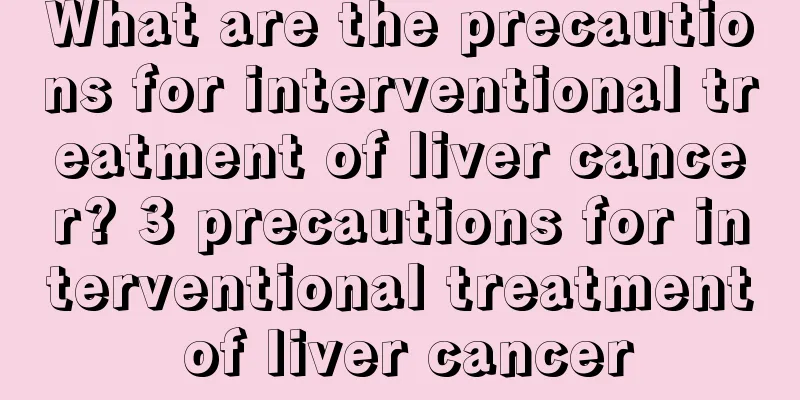What are the precautions for interventional treatment of liver cancer? 3 precautions for interventional treatment of liver cancer

|
1. Strictly grasp the indications and contraindications of interventional treatment of liver cancer. 2. Formulate a reasonable treatment plan. When formulating an interventional treatment plan, many relevant factors should be considered comprehensively, such as the size and shape of the tumor, blood supply, size and location of the tumor thrombus, arteriovenous shunt, liver function, blood count, physical potential, etc., to determine whether the patient is suitable for interventional treatment. If interventional treatment is the preferred option, choose the corresponding interventional treatment plan based on the patient's specific angiography. If angiography finds that the liver cancer is a hypovascular nodular type, the interventional treatment effect is not ideal, and other therapies should be recommended. Multi-slice spiral CT (MSCT) is one of the major advances in CT technology in recent years. Due to its fast scanning speed, it can not only display relevant information about tumors and their complications, and improve the detection rate of lesions, but also display the anatomy and course of blood vessels, the size, number, degree of enhancement and distribution range of tumors, the presence or absence of portal vein tumor thrombus, the location of formation, arteriovenous fistula, the presence or absence of obstructive jaundice and the amount of ascites, the presence or absence of abdominal lymph node enlargement, and whether the inferior vena cava is invaded. These information are of great guiding significance for judging whether the patient is suitable for interventional treatment and formulating a reasonable treatment plan. For those who are eligible, preoperative MSCT is of great guiding significance for formulating interventional treatment plans for liver cancer, performing targeted intubation, reducing the difficulty of finding target blood vessels, shortening operation time, and reducing the radiation dose of patients and interventional operators. 3. Matters that need to be noted during surgery. Because the blood supply arteries of liver cancer can mutate, the order of angiography should be noted for patients receiving treatment for the first time. Do not only perform celiac artery or superselective hepatic artery angiography. The superior mesenteric artery, celiac artery, and phrenic artery angiography should be performed in sequence, and superselective blood supply artery angiography should be performed according to the need for angiography. The intraoperative contrast agent situation should be compared with the preoperative CT and MRI examination results, and carefully analyzed to avoid missing multiple blood supply arteries that may exist. Standardized intraoperative operation not only guarantees the effect of interventional treatment, but also creates good conditions for subsequent comprehensive treatment, while reducing the occurrence of complications. During embolization, the following principles can be followed: ① Use peripheral embolic agents for peripheral embolization first, and then central embolization. ② The amount of iodized oil should be sufficient, especially during the first embolization. ③ Do not completely occlude the proper hepatic artery to facilitate TAE again, but the exception is those with obvious hepatic artery-portal vein fistula. ④ If there are two or more arteries supplying the liver tumor, each artery should be embolized one by one to devascularize the tumor. ⑤ For patients with smaller hepatic artery-portal vein fistulas, iodized oil embolization can still be used, but it should be done with caution. ⑥ Try to avoid the embolic agent entering non-target organs. When performing TAI, the amount of chemotherapy drugs used in perfusion and embolization should be allocated according to the blood supply characteristics of liver cancer. |
>>: What are the early symptoms of lung cancer? Five clinical symptoms of early lung cancer
Recommend
What's the matter with oil in the blood
The blood vessel network in the human body is ver...
Farting while pooping
Farting is a normal physiological phenomenon in t...
How to open red wine
Good red wine has many benefits to the human body...
What are the disadvantages of nail polish
Many female friends who love beauty know that man...
What are the treatments for swollen and painful finger joints
When the finger joints are swollen and painful, a...
What should liver cancer patients eat in daily life? Here are some dietary taboos for liver cancer patients
What should patients with liver cancer eat? Radio...
How can rheumatoid arthritis be completely cured
Rheumatoid arthritis is a relatively common disea...
What causes pain when pressing on the right lower abdomen?
Abdominal pain is a relatively complex symptom be...
Will the refrigerator really explode if placed in the kitchen?
The refrigerator can be said to be a must-have ho...
Does smoking harm the kidneys?
Everyone knows the harm of smoking, but in life, ...
How to adjust when the condition is not good
People eat all kinds of food, and everyone has th...
Will answering the phone frequently induce brain cancer?
The cause of brain cancer is the same as cancer i...
Remedy by whipping cream into water
With the improvement of economic level, there are...
What are the early symptoms of lymphoma and what are the treatment remedies?
What are the early symptoms of lymphoma? What are...
How to prepare nutrient solution
We have all seen a lot of soilless cultivation, i...









